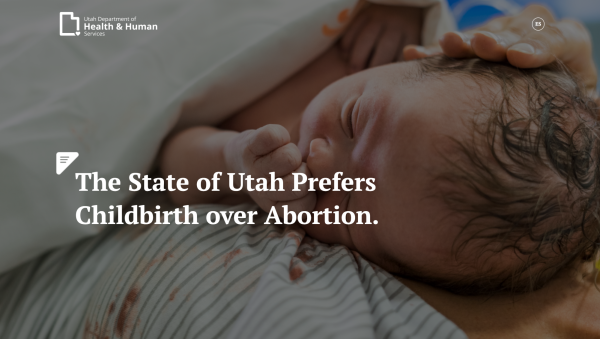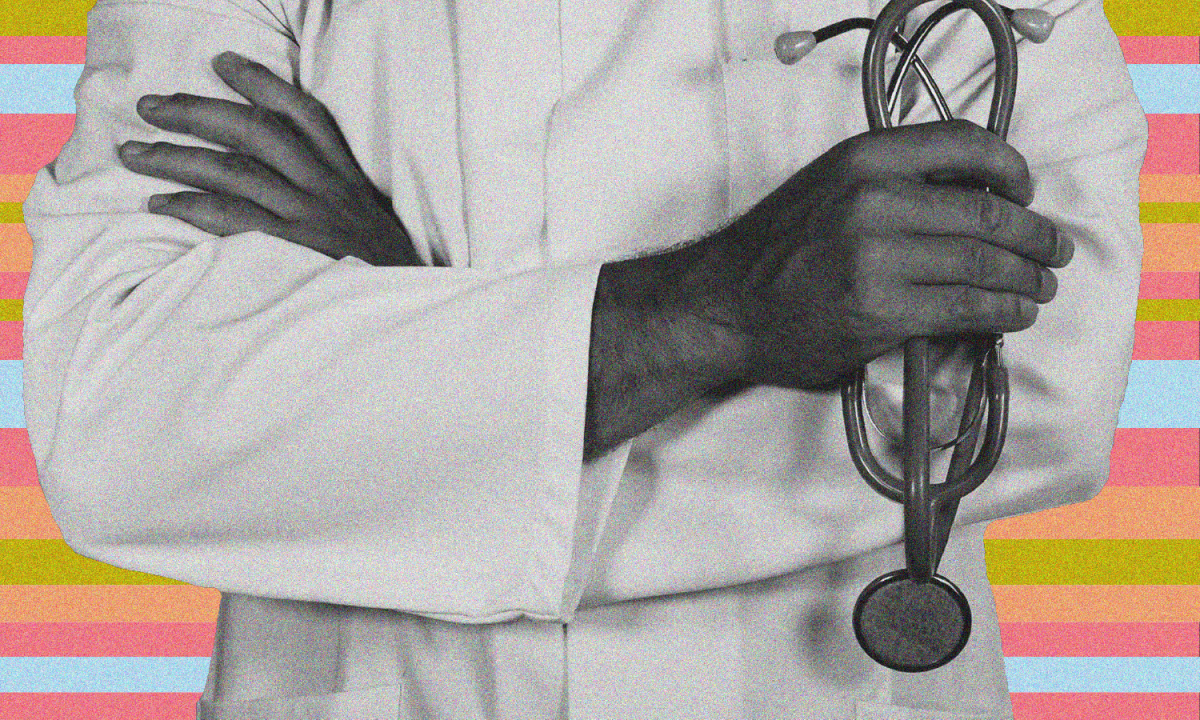A young woman from Utah found out she was pregnant over her winter break. Knowing that she would need to terminate the pregnancy, she immediately began the process to get an abortion. What she thought would be a quick and easy appointment turned into a lengthy, complicated process that would take weeks. This resulted in her having the procedure done in New York instead.
For safety from retaliation, the young woman will remain anonymous. She will be referred to as Jane Doe.
A Positive Pregnancy Test
Jane Doe, a Utah resident, currently attends university in New York. It was when she came home for her winter break that she discovered she was pregnant.
“I just started feeling so nauseous and I was so sick,” Doe said. After multiple days, she decided to take an at-home pregnancy test. The test came back positive.
“I thought, ‘Oh my gosh, there’s no way,’” when she saw the result, Doe said. She knew abortion was the option she was going to take if she wanted to continue her career path.
“My mind immediately went to the abortion route because I’m a pre-med student,” Doe said. “I’m going to graduate next year.” Having a child at that moment was “not in the cards” for her.
With the support of family and friends, Doe immediately started the process within an hour to book an appointment to get an abortion completed.
The first thing she did was call Planned Parenthood, where she had to wait over an hour on the phone before being able to get in contact with somebody.
It was on the phone that she learned Utah had some necessary steps for people to complete before they could get an abortion — including an online module and a three-day hold.
What is in the Abortion Module?
In the state of Utah, patients cannot get an abortion until they have completed an online module and received a certificate of completion. Each section is met with quiz questions to “verify [the patient’s] understanding of the information,” according to the Utah Department of Health & Human Services.
In accordance with Utah’s informed consent requirements for abortion, a person seeking an abortion must view the entire module and provide proof of completion to their healthcare provider.
The Daily Utah Chronicle completed the abortion module and spoke to a medical professional about the module and informed consent process in Utah.
Jasmin Charles is a physician assistant and adjunct assistant professor in the department of obstetrics and gynecology at the University of Utah, as well as the clinical director of SUPeRAD, the substance use and pregnancy recovery addiction dependence clinic.
“I do not have good feelings about how the state of Utah legislates reproductive healthcare rights,” Charles said. “Including abortion, but also including access to contraception, access to contraception within incarceration, and then also just choices around abortion care and abortion timing.”
Charles said she views the 72-hour wait time and required online module as “a restriction and red tape to try and decrease access.”
“There should of course be a consent … but that consent should have to be done at the time of intervention, not 72 hours before and not including a coercive module,” Charles said.
The required module includes preliminary questions asking about the length of the pregnancy and whether the pregnancy was a result of rape, followed by four sections: childbirth, abortion, adoption and aid resources. Each of the sections ends with one to two quiz questions.
The first page immediately after answering the preliminary questions in the module contains the statement: “The State of Utah Prefers Childbirth over Abortion.” This quote is placed against the background photo of a newborn baby. Charles noted that many of the images included in the module feel coercive.

The “childbirth” section of the module includes a detailed overview of the development of an embryo. It begins at six weeks with a realistic image of an embryo. Each stage of development is accompanied by the organs forming at that time, the size of the embryo and a realistic image of it.
In this section, it is emphasized that the state of Utah offers a free ultrasound to those considering abortion. Charles said the reason they offer this ultrasound is not for practical medical purposes.
“I think it’s all related to manipulation and one more attempt to make people feel bad about making a healthcare choice,” Charles said.
The “abortion” section includes four sub-sections: abortion procedures, abortion risks, fetal pain and fetal remains. The first page is information about abortion procedures and the types of abortions one can get.
The first option listed is medication-induced abortion, where a patient takes mifepristone and misoprostol to end the pregnancy. This procedure is non-surgical and can be used within the first 10 weeks of pregnancy.
According to the module, an ultrasound is done and then followed by a dose of mifepristone taken orally, at the clinic. The woman is then given misoprostol tablets to be taken between 24 and 48 hours later, at home.
“Misoprostol causes the uterus to contract, bleed, and expel the pregnancy,” according to the module.
Follow up ultrasounds can be useful to determine if the abortion is complete. If it is incomplete, vacuum aspiration, another form of abortion, is recommended.
Vacuum aspiration, also known as suction curettage, is a surgical abortion that can be done during the first trimester of pregnancy.
In this procedure, an ultrasound is done before the cervix is dilated or stretched. From here, the physician inserts a cannula, or small plastic tube, into the uterus. The cannula has a suction system and is moved through the uterus to vacuum the fetus, placenta and other tissues out.
The module provides animated videos detailing both vacuum aspiration and medication induced abortion.
It lists a third type of abortion known as dilation and evacuation, or D&E. This procedure is commonly performed in the second trimester of pregnancy.
The cervix is dilated prior to the procedure, followed by a cannula inserted into the uterus. Similar to vacuum aspiration, suction is used to take out the amniotic fluid, placenta and other pregnancy tissues. Forceps are then used to remove the fetus in parts.
Local and intravenous anesthesia accompany this procedure. An animated video for this is included in the module.
At the end of the “abortion procedures” section, there is a statement which says, “Abortion is the ending of a pregnancy and will result in the death of the embryo or fetus. When choosing abortion, you should be 100% certain of your decision.”
The user is required to select “true” or “false” in response to the statement.
The second part of this section is the abortion risks. The module notes that “nearly all women undergoing an abortion have some pain or discomfort, ranging in intensity from mild to severe.” Some of the physical risks listed are incomplete abortion, cervical injury, puncturing of the uterus, infection, heavy bleeding and allergic reactions.
Emotional reactions are also listed in the module. One reaction listed is that “women may be more likely to experience negative feelings or have difficulty after the procedure if they felt forced into a decision or if they had previous depression or other mental health issues.”
The module states that feelings after an abortion may be harder to handle if the procedure is done in secrecy or isolation. It suggests talking to a counselor before having an abortion.
Fetal pain is the third section of the module, shown to those who answer “20 weeks or more” in the preliminary questions about their pregnancy.
The module acknowledges that there is not an objective period of time in which the fetus begins to feel pain. The State of Utah believes that a fetus can begin to experience pain during an abortion procedure at at least 20 weeks gestational age.
“[The module] has some medical inaccuracies surrounding pain and the sense of feeling around a fetus,” Charles said.
According to a journal article published in 2021, “The American College of Obstetricians and Gynecologists and the Society for Maternal Fetal Medicine state that fetal pain is not structurally possible until at least 24–25 weeks gestation, that the fetus cannot be conscious of pain ‘until the third trimester at the earliest,’ (>28 weeks gestation), and cannot perceive pain as such until ‘late in the third trimester.’”
The module states that physicians can give medicine to help lessen the pain of the fetus, but there is not really evidence to know if it relieves discomfort.
The next part of the module is on fetal remains. This section details the rights a woman has to the aborted fetus — namely, putting the responsibility on the provider to dispose of it or deciding to cremate or bury remains on their own. Anyone doing the module, regardless of current pregnancy length, views this section.
Charles said this section can be misleading, as there are often not actual “remains.”
“Most abortions take place early enough that the products of conception, once put through an incinerator, are less than dust,” Charles said.
While deciding what to do with the pregnancy tissue might be important for some people, Charles said most individuals who are seeking an abortion have not considered it until they come across the module and the required disposal form.
“There are individuals who, for their belief systems and also for their mental health and their well-being, would like the option of having a service or a ceremony,” Charles said. “However, most individuals when questions are asked and surveys are taken, have never really thought about fetal products of conception as fetal remains and what to do with them.”
Charles said the inclusion of this section is “one more way to skew the mind” of an individual considering abortion, as it plays on their “implicit biases” and negative associations.
“When we bring up remains, [that] brings up potentially remembering when we buried our grandfather or our childhood dog,” Charles said. “I think it’s similar to the images and the heart rates and the ultrasounds to just try and coerce people into feeling bad about the decision that they’re making.”
The last page is adoption information. The module states that “whether you’re unable to parent a baby, having financial struggles, or wish to give your future child more than what you can offer right now, adoption can be a positive, loving choice.”
It then lists several adoption options like private adoptions (using private attorneys) or public adoption (through licensed agencies).
In addition, adoption support resources like “help in getting a job, as well as cash payments” are provided to patients who have given birth to a child that has been placed for adoption. The Department of Workforce Services may pay adoption-related expenses like legal expenses, maternity expenses, hospital expenses and temporary living expenses during pregnancy.
On the last page of this section, there is a statement emphasized in bright orange letters at the bottom of the page: “The State of Utah Prefers Childbirth over Abortion. Adoption is a preferred alternative for Abortion.”
Charles said these statements “should not be any part of an individual’s choice around their healthcare and their health.”
The quiz question for this section asks what the state of Utah prefers regarding abortion or adoption. Patients must answer “the state of Utah prefers childbirth over abortion” before proceeding to the next page.
The module concludes with “aid resources,” including for prenatal care, neonatal care, financial aid, special needs and support groups.
Charles pointed out there is a requirement for the proof of completion of the module to be printed out and submitted as a hard copy, another potential barrier for those who might not have easy access to a printer.
Obtaining Informed Consent
Once a patient completes the module and presents proof of completion, a healthcare provider must also provide a face-to-face consultation with them reviewing certain information required by the state. The patient must certify in writing that the session took place. All of these steps must take place at least 72 hours in advance of the abortion.
“Even if I complete the module today, and the 72 hour waiting period, [I’m] still gonna be weeks out,” Doe said.
During the informed consent meeting, healthcare professionals are required to read a script to patients. The patient must then sign a form stating that this session took place.
In the required “informed consent for abortion” script, the term “fetal remains” is not used. The term “pregnancy tissue” is used instead when discussing disposal. Charles said this was a decision that the medical team who helped write the script felt very strongly about.
Charles said the script was made in partnership with a team of providers. The state of Utah provided a legal outline with items that were required to be included, but they were able to “negotiate” the wording a bit.
The requirements of the state included discussion in detail of the risks of abortion, the offer of a free ultrasound, the alternatives of childbirth and adoption and choice concerning disposal of the pregnancy tissue. They also required the breakdown by gestational age, which is the reason the description of abortion methods is separated by the number of weeks pregnant.
Before stating the risks of abortion in the script, there is a clarification about how often these risks occur: “The risk of having a complication from an abortion is very low. Less than 1% of all abortion patients have a major complication. The risk of death associated with childbirth is about 14 times as high as that associated with abortion.”
Out of State Abortions & Utah Barriers
After her phone call to Planned Parenthood, when Doe was informed about the module, 72-hour hold, and informed consent meeting, she inquired about an actual appointment. The phone representative informed her that they were booked weeks out.
“They said that they were, like, weeks out and I was like okay well by the time it gets to that point, is that even going to be legal for me to get it anymore?” Doe said, worried about Utah’s 18 week ban. “I panicked [once] I could not get one in Utah … I was like, ‘what the hell, how am I not able to get this?’”
Doe described the terror she felt when faced with the idea that she might be forced to carry the fetus for a while longer, and the physical illness she was enduring on top of the mental stress.
“It’s like you’re kind of claustrophobic in your body,” Doe said. “I felt so nauseous every single day. It just was emotionally upsetting. I felt trapped.”
The physical illness combined with the emotional stress of an unwanted pregnancy created discomfort for Doe.
“[It is] terrifying to know that you’re pregnant, but then know you don’t want to be pregnant, and then be forced to stay in that condition for weeks,” she said.
Though she felt certain in the choice she was making, she felt she had to “prove it,” which was “draining.”
“I know what’s making me sick, I know I don’t want to do this, but I have to do this online module to prove to people that I am competent about my own choice,” Doe said. “It was very emotionally draining and physically draining.”
Doe’s only solution was to get the abortion when she resumed her school semester in New York, where abortions are more accessible.
“I came back [to New York] on a Monday, and they had me scheduled for a Tuesday,” Doe said. “No hiccups. It was so easy.”
She pointed out the difference between her experiences in New York and in Utah, where it was a long process of meetings, modules, appointments and waitlists.
Doe said she felt cared for throughout the process in New York.
“As soon as the appointment was over they sent me home with snacks and they had information for me in terms of things to look out for,” Doe said.
She described not feeling like a “factory, in and out.” Rather, she felt “supported before, during and after” her procedure.
She noted that the day after the appointment, a representative from the New York Planned Parenthood called her to “check on my emotional well-being and to make sure that I was doing okay.”
Doe also mentioned that the New York Planned Parenthood gave her options when it came to funding her abortion.
If a patient was worried about repercussions for an abortion showing up on a parent’s insurance, they can register through an anonymous program to protect the patient. For Doe, they offered to do this so that the termination wouldn’t be listed as an abortion on her father’s insurance.
“It was entirely free and it didn’t show up on any insurance things at all,” Doe said. “So all the resources they have here [in New York] are genuinely incredible for even non-New York residents as well.”
Doe said insurance “was not brought up at all” in Utah. The process also has other barriers that she did not face in New York.
Charles said people seeking an abortion in Utah can face barriers of transportation and cost. There are two Planned Parenthood locations in Salt Lake which provide abortions, as well as the Wasatch Women’s Center, an independent clinic.
“If you’re coming from Magna and you don’t have a car, no public transport to get in for appointments, it’s a real barrier,” Charles said.
She said there also tend to be protesters present more often at clinics providing abortion in rural areas.
“It’s really uncomfortable,” Charles said. “What if my neighbor’s the one out there protesting, you know? What if I know somebody?”
The informed consent script provides a warning to patients about the possibility of protesters being present outside the clinic at the time of appointment.
Protesters at Planned Parenthood clinics is such a common issue that the website has designated information for patients on preparing to deal with them.
The site says that “you may face vocal protesters outside who don’t believe in your right to sexual and reproductive health services and education,” adding that “these protesters shouldn’t keep you from the health care you need and deserve.”
In many cases, Planned Parenthood has “security guards and/or escorts on hand who are trained to protect you and help you get to your appointment as quickly as possible.”
The page also states to patients that “you deserve to get healthcare without shame or misinformation. If you’re worried about dealing with protesters, you can always call the health center” and they will help you get to your appointment safely.
Cost can be another barrier as abortion is not covered by insurance. Charles said there is a “sliding scale” for the cost, but the lowest it can get to is $300, which is “pretty rare.” More often, the cost is $500 or more.
While Doe is an example of someone who left Utah for an abortion, Charles said her department and co-workers have already seen patients being “airlifted” or who “drive hours and hours” to Utah from places like Idaho, where there is a near-total ban on abortion, “because they don’t have access to appropriate care in their home state.”
Abortions & Misconceptions
Doe described the thoughts that ran through her mind when she thought she would be unable to get an abortion in Utah.
“It’s kind of like you’re put in an ultimatum situation,” Doe said. “If I would have been forced to keep it, I would have had to drop out of school … when I was almost done, I would have had to throw in the towel for all the medical school stuff … do you keep going with this career path or are you gonna throw everything away?”
While some people are overjoyed to find a positive pregnancy test, this was not the case for Doe. She described the experience as being filled with anxiety and stress.
“I was very anxious about [not being able to get the procedure done] because then that was another two weeks of just knowing you’re pregnant and not wanting it,” Doe said. “It was very, very stressful for my relationship because it was kind of like ‘What do you mean you can’t get it?’”
This left her feeling trapped with an unwanted pregnancy inside of her for weeks, until she could get to New York. She experienced “a lot of panic.”
“I was so nauseous and just felt awful,” Doe said. “I should have been able to get that done when I wanted to get it done … It was frustrating because I had to do it on a week where school started again.”
Getting the abortion done in New York was efficient, but emotionally hard on Doe. She wished she could have had it done in her hometown in Utah and had the support of her friends and family while she was healing.
Instead, she had to get it done in New York, alone. This made her miss classes and endure the hardships of being away from home, which she said was “an unnecessary barrier.”
Doe said she had always assumed that if she did get pregnant in college, she could go the abortion route, which was something that she “found so much comfort in.” When it seemed unsure whether that would be an option, she describes feeling panicked and terrified.
“I felt like they were trying to kind of trap you into having a kid,” Doe said. “It’s extremely accessible here [in New York]. The difference was genuinely terrifying … it’s actually so terrifying in Utah.”
Doe also brought up the misconceptions that she feels people have about women who get abortions.
One of them, she said, is that these women just want to have abortions every other day. This isn’t the case at all, she said, talking about how the process was “traumatizing” and “very physically difficult.”
She said that many people act like abortion is “just something that’s so easy.” It isn’t, and certainly wasn’t for her, she said.
“It is not an easy decision,” Doe said. “It was incredibly painful. It was such a stressful process that no one is going to do that lightheartedly, or having fun.”
















Hailee White • May 28, 2024 at 12:08 pm
Incredible investigative article. Not one-sided or biased at all😂
Darla, RN • May 26, 2024 at 10:47 am
Thank you for this important and detailed missive from the front lines of women’s healthcare. It is shocking what is happening in states like Utah where one might assume, since termination is legal, it would be a comparable experience to New York. Clearly there is “fetal bias” in Utah, and clearly the pregnant woman’s experience as a patient does not hold great value. It approaches the infliction of trauma. Further thanks to Jabne Doe for sharing her experience with the writer, and I extend my best wishes to her in her career in medicine. I expect her experience as a patient in differing systems of care will add value to her ministrations as a doctor.
Karen Baker • May 25, 2024 at 8:08 am
The hoops a woman has to jump through in Utah to get an abortion are disgusting. It’s state control over a woman’s body, viewing her as no more than a broodmare. Tell me, are there bills in the works, to send her to a kill auction when her breeding days are over, to be sold for slaughter?
Yet, the state provides all sorts of incentives to get women to put babies up for adoption. How about offering those incentives to women so they can afford to complete their education, have a decent place together buy, get groceries every week, have reliable car to get to work, to pay utilities, to keep herself and the family she chooses to have, in clothes?
Thus is barbaric.